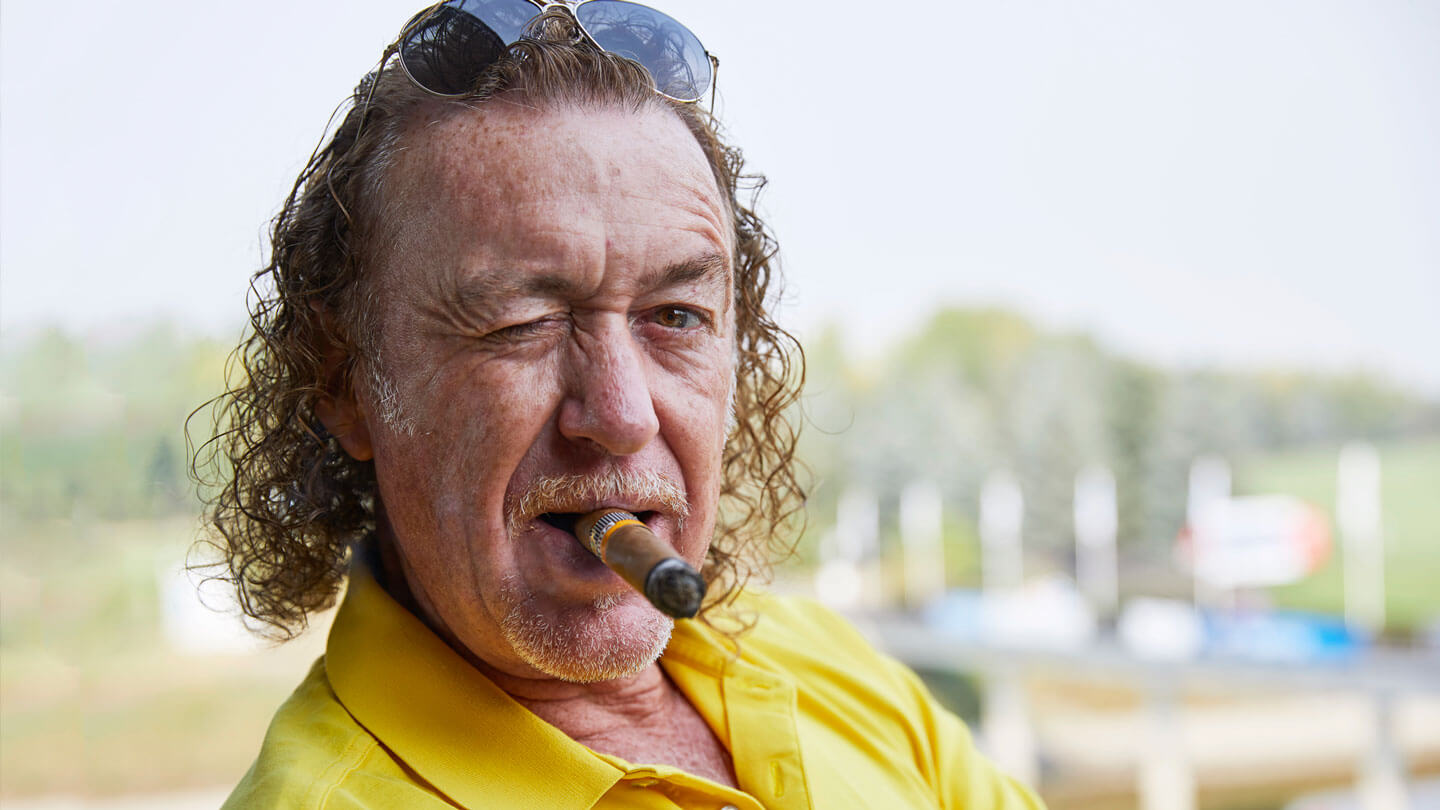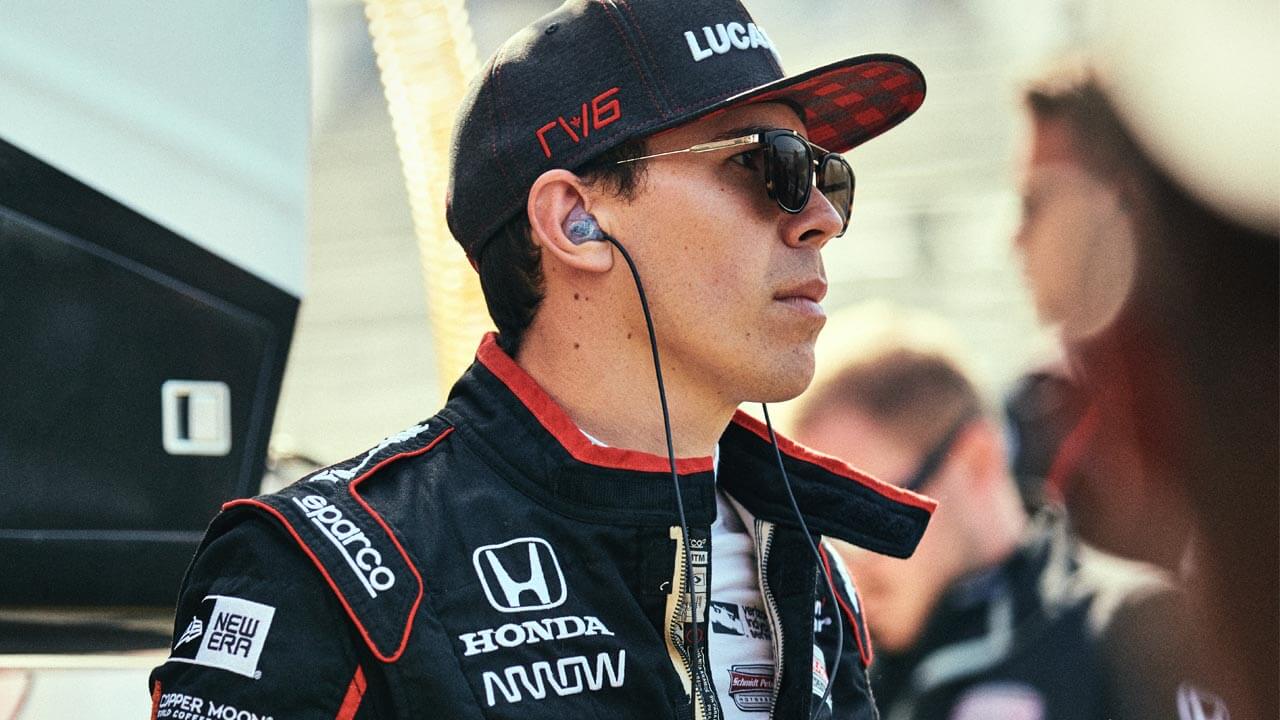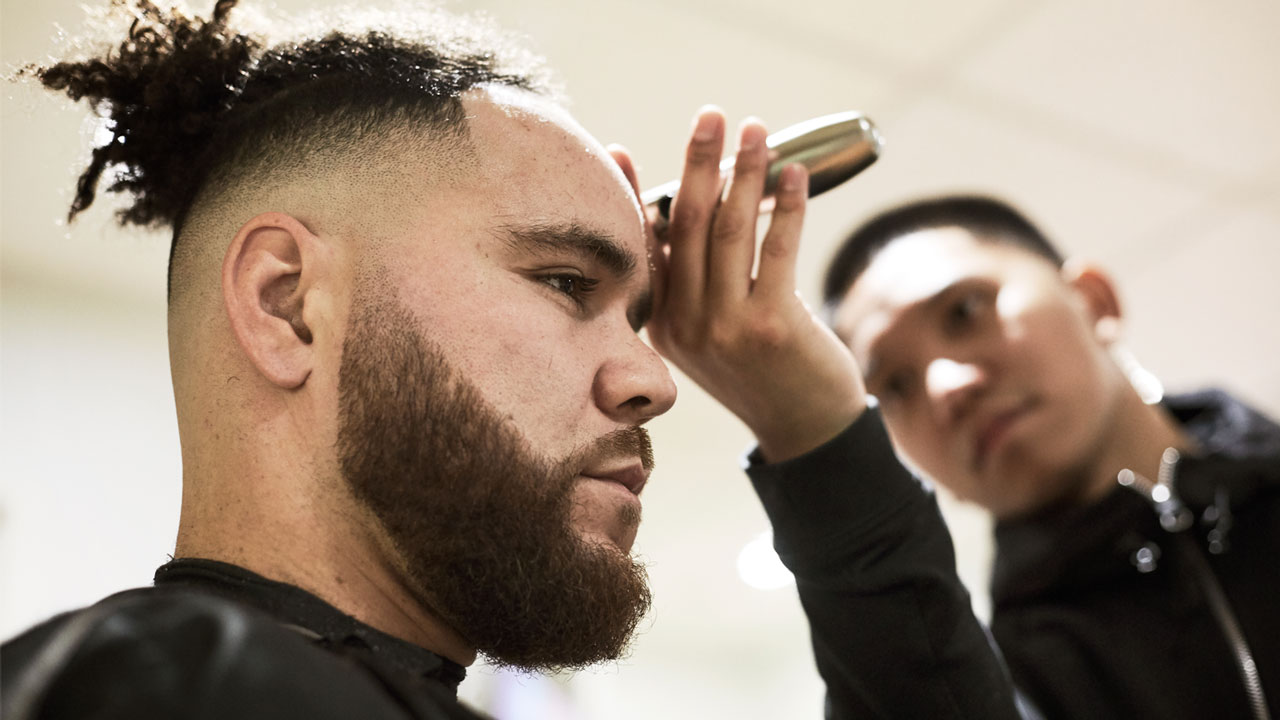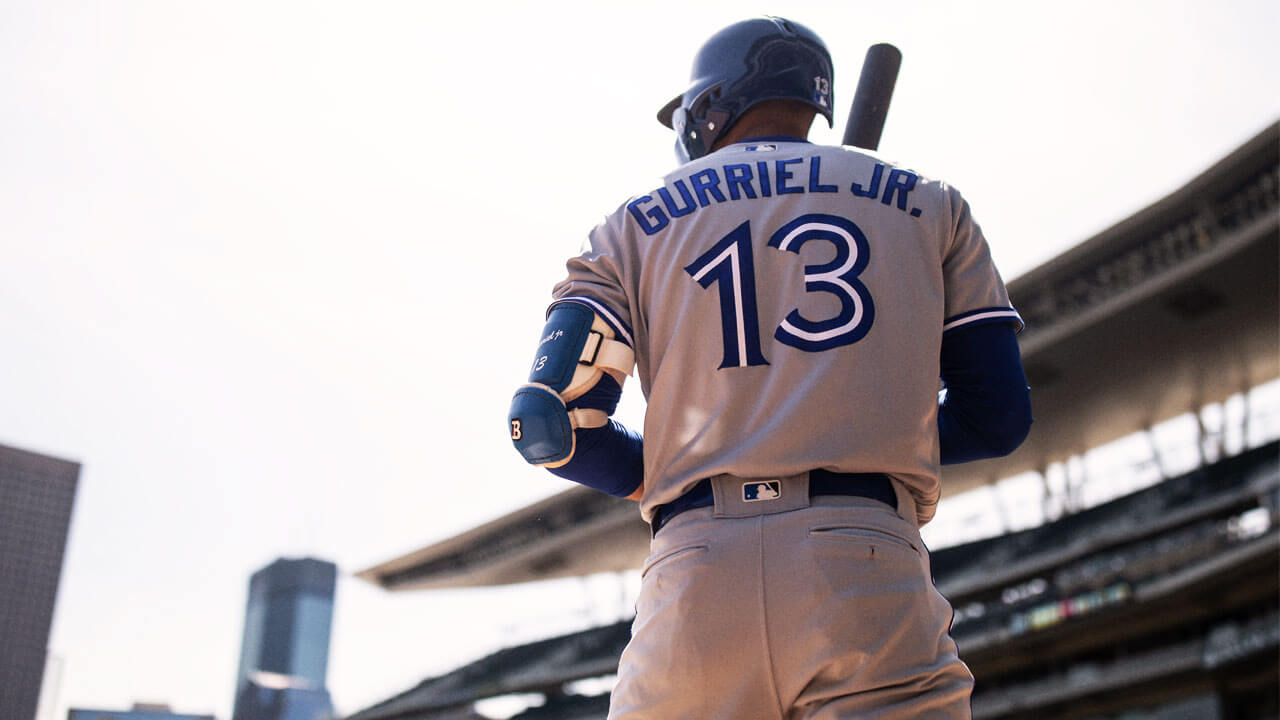His eyes are shielded by aviator sunglasses, and Miguel Angel Jimenez takes a big puff of his cigar as he prepares to explain his thoughts on aging. “Age is coming,” he says, leaning back in his course-side patio chair, straight-faced as can be and using his free index finger to underscore his point, “but I’m not getting old.”
Nice as it sounds, that makes very little sense. Luckily, the Spaniard, now 54 years young, offers further clarification: “I look in the mirror today, I’m looking at the same guy.”
On this sunny day in Calgary, that same guy’s signature curly ponytail, with tinges of blonde and brown and red and grey, sticks out behind a visor. His golf shirt is a shade of yellow so bright it’s visible from a mile away, and he’ll soon replace his loafers with spikes for morning practice. “I’m lovely,” Jimenez says, brushing a large chunk of ash off his pants — he likes to avoid ashing his cigar as long as he can, consequences be damned. “When I look in the mirror, I love what I see here. I’m 20, 21, 22, 21 — same guy.” He waves his free hand up toward his face, “Handsome, beautiful, nice, funny,” he says. “Everything.”
The Most Interesting Man in Golf introduced himself just minutes ago, and he wasted no time in living up to the Dos Equis-inspired nickname he earned about a decade ago. Many of his colleagues on Tour have conceded Jimenez is the coolest man in their sport, the player who once lit up a cigar in a post-round press conference (he was promptly told to please put it out), the guy whose European Tour online biography includes just one word in the “interests” category: Cars. His love of fine automobiles — Ferraris in particular — is, after all, the reason for Jimenez’s longer-standing nickname, The Mechanic.
Whatever you want to call him, Jimenez remains one of the most recognizable personalities in golf, despite the fact he never won a major in the sport’s top ranks, or even a title on the PGA Tour. His appeal has always been his presentation — that hair, the love of stogies — and his seemingly effortless talent. And now that he’s in the latter stages of his career, playing on the PGA’s circuit for the 50-plus crowd, Jimenez is more important than ever. As Fred Funk, a nine-time winner here and eight-time winner on the younger man’s Tour explains it, “He’s one of the guys we need out there on the Champions Tour, to be the draw. Miguel’s our entertainer.”
Indeed. Jimenez’s pre-round stretching routine could double as a comedy skit with zero alterations. But make no mistake: he’s no clown. The affable Spaniard may joke about having brandy in his morning coffee and he may light up his first cigar on this particular day just after the clock strikes 10:00 a.m., but he takes this game as seriously as anyone — and brings more passion and dedication than most. Jimenez has already been to the gym this morning, he’ll have you know, “and,” he says, “I didn’t see you there.” Touché.
Now in his third season on the Champions Tour, Jimenez won the first major of his career in May, the Regions Tradition, and in early July he was second at the Senior U.S. Open. A win at the upcoming Senior British Open would earn him entry into the Open Championship, where he finished T18 two years ago. And the thing about Jimenez is that even if he swears he hasn’t changed, he’s actually one of few in this game who has improved with age. “Golf gave me life,” he explains, just before a small group of fans follows him over to the practice green. “I’m giving my life to golf.”

Life didn’t begin with the finer things for young Miguel Angel Jimenez, the fifth of seven brothers. He grew up poor in Malaga, a port city on Spain’s southern coast. “We have to talk about this?” he asks, sitting back outside the clubhouse at Canyon Meadows G&CC, host of the Shaw Charity Classic. Jimenez may boast about his beauty, but he doesn’t love it when conversation focuses on him for too long. The idea that a reporter would call up some of his best friends to talk about him would only “embarrass” Jimenez, explains Sarah Phillips, his manager of 20 years. “OK, OK,” he says, finally. “When we are kids, we have two rooms for seven brothers, four in one room and three in the other.” One bedroom had a bunk bed, while the other had a big bed a few brothers shared. “And then, we golf,” he says.
Jimenez didn’t actually take his first swing until he was 14, though, and he was hardly a natural. During his school years, he spent his weekends collecting balls on the range and caddying at the local golf club, Torrequebrada, though he admits he knew very little about the sport. “I wanted to eat, so you need to work,” he says. “Once I finish my studies, I started to work in a garage for a few months and then it closed, so back on the golf course, I work. That’s when I start to see the beauty of golf.”
He left school for good at 15 and began playing every day, an unpopular move in the eyes of his parents, who wanted him to pursue a stable career. Jimenez forged ahead, though, largely self-taught, because lessons were unaffordable. To this day, his older brother Juan remains his only consistent coach. When they were teenagers, Juan taught lessons at Torrequebrada. “I say, ‘Hey, brother, I want to do that,’” Jimenez recalls. “He tells me, ‘OK, you practice, you do what you do, you do good.’ That was the beginning.”
The signature long, curly hair was already there when he turned professional at 18, but Jimenez’s golf career didn’t exactly take off. First, he had to fulfill mandatory military service in Spain, which also meant losing that hair. “I have to spend 15 months with the military, wasted my time,” Jimenez says, hands waving. “We are with the military, moving here, moving there with the machines and fly in the airplanes and see things like that. We don’t have any war, anything to fight, you know? Waste.”
After his service was complete, Jimenez returned to Torrequebrada to caddy, collect balls, teach lessons “and of course I practice always in between,” he says. For the next few years he played tournaments all over Europe, piling into a car with a few other pros, teeing it up in Spain and Italy and France and Switzerland, trying to earn a paycheque. “You have a lot of pressure,” he explains, the pressure of trying to support not only himself, but also his parents and brothers. “You think you cannot play forever because I have no money, so how can I keep playing?”

Jimenez was dogged in his pursuit. He uses his cigar-free hand to count, in Spanish, the number of times he went to the European Tour’s qualifying school, the gruelling three-stage quest to earn a Tour Card and guarantee himself starts on that loop. He settles on cuatro. While Jimenez played his debut tournament on the European Tour in 1983 — a missed cut at the Spanish Open — it wasn’t until six years later, in 1989, that he earned his Tour card. You’d hardly recognize him then, a short-haired 24-year-old who smoked cigarettes. “He wasn’t the same animal that he is now,” says Phillips. Jimenez missed the cut in his first four tournaments in ’89, but ended with one top-10 finish and £41,687. His first of 21 titles on the European Tour came three years after that, at the Paget Belgian Open.
Jimenez worked his way into the top 50 world ranking by 1994, but fell back outside the top 100 in 2002 while trying to fulfill minimum tournament requirements on both the European and PGA Tours. The travel demands were tough, he says. To turn his game around, he decided to reinvent himself as the animal we know now. “I said, ‘You gonna change your style,’” he explains, gesturing from his head to his toes. “No, not your style,” he reconsiders, “your image — I cannot change myself. Me, it’s only one.
“Irreplicable,” he adds, grinning.
And so, Jimenez ditched cigarettes in favour of cigars — which, he points out have the added benefit of being “less worse for you” — and he grew his hair again. “I started putting the pony tail and then my game, it start to come back,” he says. “It’s not because of the hair, it’s because I practice a lot, of course. But you start winning tournaments again.” In 2003, at 39, Jimenez won twice on the European Tour. His best season yet came a year later, at 40, when he racked up four wins, earned more than €2 million and hit a career-high No. 12 in the world. “Then I say, ‘It’s not time to cut the hair,’” he recalls. “That’s the image now, the guy with the ponytail and the cigar in the mouth.”
That guy played the most consistent golf of his life in his 40s, winning 12 times on the European Tour. And his best-ever finish at the Masters came at 50, when he finished T4, the second-best finish at Augusta ever for anyone half a century or older behind Sam Snead, who was T3 at 50 in 1963. So far in his 50s, Jimenez has racked up seven wins, five on the Champions Tour and two on the European Tour, where he’s now playing his 30th season.
No drastic change to his swing led to this late-in-life success. Nor was it a new driver, a hot putter, fine wine or Cuban cigars. Jimenez explanation comes through his wide, Cheshire grin. “I’m self-made,” he says.
And then he blows a puff of smoke in my face.

Morning practice is about to start, so It’s time for the shimmies and shakes, the most famous stretching routine in golf. Jimenez is standing near the practice green, and he leans down and places his burning stogie into its special holder, a white plastic golf ball with a hole bored through the centre that’s sunk into the grass via a tee-like bottom. The holder was a gift from a fan.
He begins with squats, club held perpendicular in front of him. Then Jimenez brings his feet closer together and rotates his knees clockwise. He reverses the direction for a few revolutions, then shifts his legs side to side. He takes a club behind his back and leans to the right, then flashes a smile and holds that stretch for a few extra beats, so fans can capture the moment.
Nobody on Tour plays the crowd quite like The Mechanic, who’ll be the first to tell you these stretches are “very important,” and not only so that he can “stay elastic,” as he puts it. “People love to watch that, and I love it,” Jimenez explains after he’s limbered up. “That’s what we’re here for. We are here to entertain the people.”
Follow Jimenez during a pro-am round ahead of a tournament and you’ll hear him talking about cigars with fans. He’ll crack jokes with the lucky sponsor assigned to his group. He’ll sign autographs. But come tournament time — Friday through Sunday on the Champions Tour — the focus shifts entirely. “It’s because that’s his time to work,” says his caddie, Cliff Botha. “He’ll give you time when he’s got time — and when people have a second with him, they’re in seventh heaven. But by Friday he won’t have time because he wants to work, he wants to do well.”
Of course, the hard work doesn’t just come on the weekends — something those who know him feel the need to explain, possibly because of the image presented by the cigar-in-mouth, and Jimenez’s belly, which Both points out “has gone down” in recent years. “It’s a myth that he just turns up, does a bit of stretching and off he goes and plays and does very well,” Phillips says.
Funk, who’s been on the Champions Tour more than a decade, was a little surprised to learn of Jimenez’s work ethic. “You look at him and you think the guy never goes to the gym, but he’s in there every day, and he works hard,” the 62-year-old says. “He’s on the bike, he’s working up a sweat. He’s incredibly dedicated.” And while the stretching may look fun, Funk tried it once. “I couldn’t even do it!” he says. “Honestly, Miguel has a lot of rhythm.”

Jimenez made fitness a priority about 15 years ago, and doubled down on that commitment after breaking his leg in a skiing accident in 2012, just before he teamed up with Botha. “He’s a workaholic,” the South African-born caddy says. “Everything he does, he does intense.” Jimenez sometimes travels with a personal trainer and he’s in the gym twice a day on non-tournament days. He loves red wine, but rarely more than a glass with dinner. “He doesn’t keep a bottle in the bag or anything like that,” Phillips says. Nor does he smoke cigars during tournament rounds; the cloud of smoke only surrounds him at practice.
This is hardly to say Jimenez presents a false image of himself: The man is every bit as entertaining as he seems. “Every day, it’s something,” Botha says, grinning as he remembers the time they went out to a restaurant and Jimenez actually went back into the kitchen to help prepare their meal. (He loves cooking, and paella is a specialty. Every year in Calgary during the tournament, he dons an apron and chef’s hat and cooks shrimp for his fellow golfers and a group of resident chefs.) It was Jimenez who struck up the partnership with Botha, five years ago, asking if he’d be interested in caddying for him. It was a no-brainer. “What kind of question is that?” Botha says, though he admits he was intimidated at first. “Miguel is world class. Not that the guys I worked for before are not, but Miguel is just up there. The world knows Miguel. What I thought at the beginning when I started caddying for him is, ‘What in the world can I tell him to help him?’ Because he’s so good.”
What Botha found is not only is Jimenez entertaining, he’s also polite. He never carries a bad round with him once it’s over and he involves Botha in decisions on the course. The conversation is always going between them. This morning on the driving range, Botha shows Jimenez a quick video of his swing on an iPad. “Much better!” Jimenez says.
That swing is a unique one, with a bit of a hook at the top, or “a little twirl,” as Botha describes it. “It doesn’t really stay on the proper plane,” Funk observes, “but it’s very repeatable. He makes it work, that’s for sure.” And because he’s hardly one of the long-bombers in today’s game, one of Jimenez’s strengths is his imagination on the course. “There’s no standard shot,” Botha says. “He plays with the ball, left-to-right, right-to-left. He shapes it.” Jimenez characterizes his style as “old school.”
He produced top-10 finishes in his last two tournaments of 2017 on the European Tour — while playing with what he calls “the young spirits.” In his first four tournaments of this calendar year on that loop, Jimenez fared no worse than T19, his stroke average ranks third-best overall, and he fired a round of 67 to open the Shot Clock Masters in June. His average driving distance has increased this year compared to last, and it’s more than 10 yards longer than when he was in his 40s.

Jimenez chalks the improvement up to better clubs, one of many changes he’s lived through in this game since turning pro. “We play hard balls with soft covers now, and we’re settling into these metal woods that we keep calling ‘wood’ — they still calling wood but it’s metal, you know?” he says, shaking his head. “The ball is going so fast from the club, and people make amazing distance now. That’s the biggest difference in golf from before to now, all the material coming up and the way the people prepare themselves.”
The changing approach of young athletes has taken some getting used to. Funk remembers the first time he ever played alongside Jimenez, ahead of the 2011 U.S. Open, later won by a kid from Northern Ireland named Rory McIlroy. The Wednesday of that tournament, Funk and Jimenez played a practice round with Francesco and Edoardo Molinari, a pair of then-20-something brothers. “I’ll never forget. Miguel’s smoking a cigar, he’s playing and concentrating, but at the same time he’s interacting with his caddy and me and the fans, just being Miguel. He’s pretty laid back,” Funk recalls. “And then he just says, in broken English and with his Spanish accent, ‘Fred, I no understand these young guys out here now — they have no fun. Why they have no fun? We playing golf for a living. We should have fun and they should laugh and not be so serious all the time!’”
Today, Jimenez’s brow furrows when he’s asked what he loves so much about this game. When he’s not competing, he’s playing with his two sons (the eldest, Victor, recently turned pro, the youngest, Miguel Angel Jimenez Jr., is a university player with a scratch handicap) or he’s working at his golf academy in his hometown, designed to make his sport affordable. “Why are people desperate to come on the weekend to play golf? It’s something you cannot explain sometimes,” he says. “With the ball disappears everything with your mind.”
This 30th year on the European Tour has Jimenez reflecting on seasons past. “You realize what you’ve been doing with your life, walking around the world with a golf ball in hands,” he says. “This 30 years, I feel proud of that, because I’ve been doing what I like to do with my life. Golf is not only my job, it’s also my hobby.
“For me, the more important thing is what I’ve been through. I played once with Arnold Palmer. I played several times with Nicklaus. I played with Tiger. I played with, ah, f—, I play with the different generations. I’ve been playing with the history of golf. That’s what is amazing.”
Yes, The Most Interesting Man in Golf has seen a lot in his career, and he’s been around a long time. But he wants to keep one thing straight: “I never get older, OK?” he says, that large grin sweeping across his face. “It’s good.”





